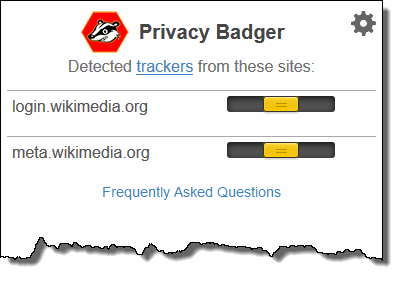Privacy Badger is a relatively new anti-tracking browser add-on coming to us from the EFF (Electronic Frontier Foundation). Privacy Badger is similar to but inherently different from other anti-tracking and ad-blocking add-ons such as Ghostery, Adblock Plus, and Disconnect.
Privacy Badger is a browser add-on that stops advertisers and other third-party trackers from secretly tracking where you go and what pages you look at on the web. If an advertiser seems to be tracking you across multiple websites without your permission, Privacy Badger automatically blocks that advertiser from loading any more content in your browser. To the advertiser, it’s like you suddenly disappeared.
Privacy Badger is NOT an ad blocker per se and doesn’t automatically block all ads but rather monitors and adapts to third-party tracking activity as you go. If a third party is engaging in activity that is deemed to be invasive of privacy, then both their cookies and ads are blocked.
What sets Privacy Badger apart from the rest is that is doesn’t rely on any pre-defined universal blacklist but rather builds its own blacklist as it goes along based on heuristics (behavioral based rules). This means that Privacy Badger is constantly learning and growing more and more effective. Out of the box, Privacy Badger won’t block as many third-party requests as other similar add-ons, but as you use it, the more it will learn and the more it will block.
This learn and adapt approach also means that the expanding blacklist is built on each individual user’s surfing habits, providing a personalized privacy defense without requiring any user configuration. However, Privacy Badger does come with a whitelist of known good and reputable sites as well as manual options for individual sites:
 Privacy Badger – Download and Usage
Privacy Badger – Download and Usage
Privacy Badger is available as an add-on for Firefox and Google Chrome, here: https://www.eff.org/privacybadger. It’s still in Beta mode so liable to include minor bugs, but I’ve been using it in Firefox for over a week now with zero issues. It also appears to have had no discernible negative effect on browsing speed or site rendering.
Privacy Badger plonks a new icon at the end of the browser’s address bar but there is absolutely zero popups or user decision making involved. The icon is inactive until clicked on and then displays information relative to the current site:

Privacy Badger utilizes a color coded system of reporting, described by the developer thus:
- Green means there’s a third party domain, but it hasn’t yet been observed tracking you across multiple sites, so it might be unobjectionable. When you first install Privacy Badger every domain will be in this green state but as you browse, domains will quickly be classified as trackers.
- Yellow means that the third party domain appears to be trying to track you, but it is on Privacy Badger’s cookie-blocking “whitelist” of third party domains that, when analyzed, seemed to be necessary for Web functionality. In that case, Privacy Badger will load content from the domain but will try to screen out third party cookies and supercookies from it.
- Red means that content from this third party tracker has been completely disallowed.
Bottom Line
As opposed to most other blockers, Privacy Badger is developed by a nonprofit, which means its emphasis is entirely on efficacy. It is also different from similar blockers in that it utilizes a user-generated blacklist, blocking objectionable behavior as you browse, rather than relying on the centralized blacklist approach.
- Privacy Badger’s home page includes a comprehensive list of FAQs for your further edification, check it out here: https://www.eff.org/privacybadger
I really like the concept… highly recommended!



Seems to only work with Firefox and Chrome. Pity (no IE support), Mindblower!
Yes MB, there is no IE version as yet… not sure why.
As you say, seeing how there are a lot of people using IE, it is a pity. Hopefully, the EFF has plans to rectify the situation.
This looks like a useful tool and I appreciate DCT and you, Jim, bringing it to our attention. I find it a bit ironic, though, that while DCT is promoting this tool that detects things that are not obvious to the user, DCT seems to be using more and more ads that are entirely too obvious to its readers. I’m referring to ads that appear not just alongside articles, but right in the middle of them. In this article, I see an ad between the headline and the first text, but even worse, there is an ad right in the middle of a paragraph. This latter one made me go back to see if I had read the text correctly. Very confusing and distracting.
Hi Patrick – I can assure you that the number of ads has not been increased at all. The ads are placed randomly… each time someone opens a page the ads will be in a different position. We don’t have any control over the placement of ads and, of course, we need them in order to keep the site going. As it is, revenue from ads barely covers our monthly expenses.
We do apologize for any inconvenience mate, we don’t really want the ads either. As an author, I do not appreciate it when an ad is placed in such a way that it interrupts the flow of the article. We’d like nothing more than to do away with ads altogether but alternative avenues for generating a little income are very difficult to come by, or even less palatable than the ads.
Cheers… Jim
No IE support!
SPAM PROGRAM!
Why is it a “spam program” because it doesn’t support IE? Kindly elaborate.
There are inherent issues with creating browser add-ons for IE, that’s why not many are available. Ghostery, Disconnect, Priv3, and HTTPS Everywhere do not support IE either, are they all spam programs?
Please correct me if I’m wrong. If there is no initial ‘active’ blacklist then doesn’t that put you at risk at least for that period of time until it or the user creates one?
No, that is not correct Graham. Privacy Badger employs heuristics as well as a blacklist – that is, it flags unwanted activity based on a set of rules. Once suspect activity has been confirmed, it will then be added to the blacklist for automatic blocking, as in no further analysis required.
The blacklist will grow over time but the heuristics will still keep working, identifying anything new that includes potentially unwanted behavior.
That’s what stands Privacy Badger out from the rest, the fact that it doesn’t rely solely on a centralized blacklist and continues analyzing.
Badger on my Yahoo mail will not stop .com or .net ads. Am I missing a setting or is that how it works?
Don – Privacy Bagder is not a total ad blocker, it is more concerned with anti-tracking and only blocks targeted ads associated with third party trackers. This from the article: